
Operation Jubilee or the Dieppe Raid was an Allied amphibious attack on the German-occupied port of Dieppe in northern France, during the Second World War. Over 6,050 infantry, predominantly Canadian, supported by a regiment of tanks, were put ashore from a naval force operating under protection of Royal Air Force (RAF) fighters.

The State of India, also referred as the Portuguese State of India or simply Portuguese India, was a state of the Portuguese Empire founded six years after the discovery of a sea route to the Indian subcontinent by Vasco da Gama, a subject of the Kingdom of Portugal. The capital of Portuguese India served as the governing centre of a string of military forts and trading posts scattered all over the Indian Ocean.

Salsette Island is an island in Konkan division of the state of Maharashtra, on India's west coast. Administratively known as Greater Mumbai, the city district of Mumbai, Mumbai Suburban district, Mira Bhayander, and a portion of Thane lie within it, making it very populous and one of the most densely populated islands in the world. It has a population of more than 20 million inhabitants living on an area of about 619 square kilometres (239 sq mi).

The history of Goa dates back to prehistoric times, though the present-day state of Goa was only established as recently as 1987. In spite of being India's smallest state by area, Goa's history is both long and diverse. It shares a lot of similarities with Indian history, especially with regard to colonial influences and a multi-cultural aesthetic.
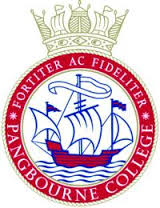
Pangbourne College is a co-educational private day and boarding school located in Pangbourne, Berkshire. It is set in 230 acres, on a hill south-west of the village, in an Area of Outstanding Natural Beauty.

Maritime powers in the Indian subcontinent have possessed navies for many centuries. Indian dynasties such as the Cholas used naval power to extend their influence overseas, particularly to Southeast Asia. The Marakkar Navy under Zamorins during 15th century and the Maratha Navy of the 17th and 18th centuries fought with rival Indian powers and European trading companies. The East India Company organised its own navy, which came to be known as the Bombay Marine. With the establishment of the British Raj after the Indian Rebellion of 1857, the small navy was transformed into "His Majesty's Indian Navy", then "Her Majesty's Indian Marine", and finally the "Royal Indian Marine".

The Battle of Madagascar was a Allied campaign to capture the Vichy French-controlled island Madagascar during World War II. The seizure of the island by the British was to deny Madagascar's ports to the Imperial Japanese Navy and to prevent the loss or impairment of the Allied shipping routes to India, Australia and Southeast Asia. It began with Operation Ironclad, the seizure of the port of Diego-Suarez near the northern tip of the island, on 5 May 1942.
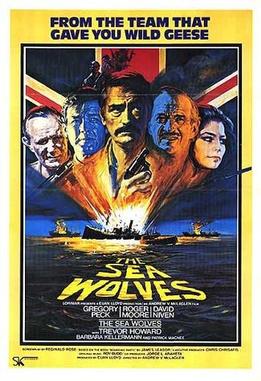
The Sea Wolves is a 1980 war film starring Gregory Peck, Roger Moore and David Niven. The film, which is based on the 1978 book Boarding Party by James Leasor, is the true story of Operation Creek during the Second World War. In the covert mission, the Calcutta Light Horse, part of the Cavalry Reserve in the British Indian Army, successfully sank a German merchant ship in Mormugão Harbour in neutral Portugal's territory of Goa, India on 9 March 1943. The ship had a secret radio which was transmitting information about Allied shipping to U-boats operating in the Indian Ocean.

Mormugao is a seaport city situated in the eponymous Mormugao taluka (municipality) of the South district, in the Goa state, India. It has a deep natural harbour and remains Goa's chief port.
The Calcutta Scottish was a regiment of volunteers of Scottish descent raised in 1914 as an infantry regiment of the British Indian Army. The regiment formed part of the army reserves of the Auxiliary Force, India (AFI). The regimental dress uniform was Hunting Stewart tartan. The regiment was disbanded following India's independence in 1947.

At the start of World War II in 1939, the Portuguese Government announced on 1 September that the 550-year-old Anglo-Portuguese Alliance remained intact, but since the British did not seek Portuguese assistance, Portugal was free to remain neutral in the war and would do so. In an aide-mémoire of 5 September 1939, the British government confirmed the understanding. As Adolf Hitler's occupation swept across Europe, neutral Portugal became one of Europe's last escape routes. Portugal was able to maintain its neutrality until 1944, when a military agreement was signed to give the United States permission to establish a military base in Santa Maria in the Azores and thus its status changed to non-belligerent in favour of the Allies.

The Star of India refers to a group of flags used during the period of the British Raj in the Indian subcontinent. India had a range of flags for different purposes during its existence. The Princely states had their own flags which were to be flown alongside the British flag as a symbol of suzerainty. The official state flag for use on land was the Union Flag of the United Kingdom and it was this flag that was lowered on Independence Day in 1947. The flag of the governor-general of India was defaced with the Star of India. The civil ensign and naval ensign were the Red Ensign or Blue Ensign, respectively, defaced with the Star of India emblem.
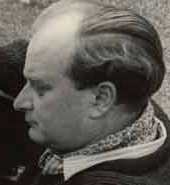
James Leasor was a prolific British author who wrote historical books and thrillers, and was one of the best-selling British authors of the 20th century. After beginning his writing career as a journalist he wrote more than 50 books, some of which were made into films, including his 1978 historical novel Boarding Party, the story of a secret incident from the Second World War, which became The Sea Wolves (1980) starring Gregory Peck, Roger Moore and David Niven.
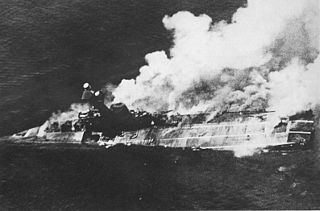
Prior to World War II, the Indian Ocean was an important maritime trade route between European nations and their colonial territories in East Africa, the Arabian Peninsula, British India, Indochina, the East Indies (Indonesia), and Australia for a long time. Naval presence was dominated by the Royal Navy Eastern Fleet and the Royal Australian Navy as World War II began, with a major portion of the Royal Netherlands Navy operating in the Dutch East Indies and the Red Sea Flotilla of the Italian Regia Marina operating from Massawa.

Operation Postmaster was a British special operation conducted on the Spanish island of Fernando Po, now known as Bioko, off West Africa in the Gulf of Guinea, during the Second World War. The mission was carried out by the Small Scale Raiding Force (SSRF) and the Special Operations Executive (SOE) in January 1942. Their objective was to board the Italian and German ships in the harbour and sail them to Lagos. The SSRF under the command of Major Gus March-Phillipps left Britain in August 1941 and sailed the Brixham trawler, Maid of Honour, to the Spanish colony.
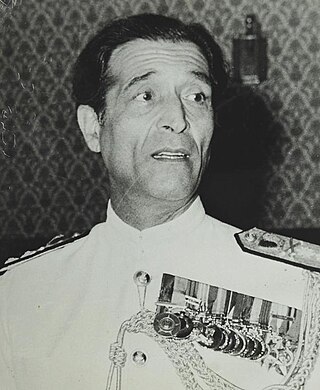
Vice Admiral Rustom Khushro Shapur 'Rusi' Ghandhi, PVSM, VrC was a former flag officer in the Indian Navy. He last served as the Flag Officer Commanding-in-Chief Western Naval Command from 1977 to 1979. He is the only officer to have commanded ships in all wars and conflicts post Independence. He commanded the frigate INS Betwa (1959) during the Annexation of Goa, the destroyer INS Khukri (F149) during the Indo-Pakistani War of 1965 and the cruiser INS Mysore (C60) during the Indo-Pakistani War of 1971.
Operation Creek was a covert military operation undertaken by Britain's Special Operations Executive in World War II on 9 March 1943. It involved a nighttime attack by members of the Calcutta Light Horse and the Calcutta Scottish against a German merchant ship, the Ehrenfels, which had been transmitting information to U-boats from Mormugao Harbour in neutral Portugal's territory of Goa. The attack was successfully carried out, and the Ehrenfels and three other Axis merchant ships were sunk, stopping the transmissions to the U-boats.

The Attack on Convoy AN 14 was a naval engagement during the Second World War between a British naval force defending a convoy of merchant ships, sailing from Port Said and Alexandria to Piraeus in Greece and two Italian torpedo boats which intercepted them north of the island of Crete on 31 January 1941. The Italian vessels, Lupo and Libra launched two torpedoes each. The torpedoes fired by Libra missed their target but one from Lupo hit the 8,120 GRT British tanker Desmoulea which had to be towed to Suda Bay in Crete and beached; the ship was disabled for the rest of the war. One other merchant ship turned back; the other eight vessels reached Piraeus.
Mormugao Port Authority (MPA) is a port on the western coast of India, in the coastal state of Goa. Commissioned in 1885 on the site of a natural harbour, it is one of India's oldest ports. The port employs around 2,600 employees and has about 4,000 pensioners.
Major-General Lewis Henry Owain Pugh was a British Army officer.















